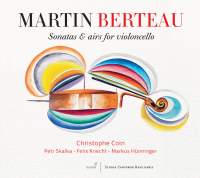Texte paru dans: / Appeared in:

Fanfare Magazine: 38:1 (09-10/2014)
Pour
s'abonner / Subscription information
Les abonnés à Fanfare Magazine ont accès aux archives du
magazine sur internet.
Subscribers to Fanfare Magazine have access to the archives of the magazine
on the net.
Glossa
GCD922512

Code-barres / Barcode : 8424562225121
(ID409)
Martin Berteau (c. 1700–1771) was an extremely successful cellist and teacher, credited with creating the French school of cello playing. He began, as did other French cellists of his day, on the viol da gamba, and later maintained to have learned the cello while in Bohemia. Charismatic and popular, seemingly every fame-seeking cellist in France at the time claimed to have been his student; and verifiable accounts show he taught at least several of the more important cellists of the next generation. He was also the subject of many word-of-mouth anecdotes from the following century that are completely unverifiable, such as claims that he was a constant drinker even during performance. For the longest time several of Berteau’s compositions were considered doubtful as well, since his earliest published works, a collection of cello sonatas from 1748, were attributed to “Sgr. Martino.” The Third Sonata made the rounds in the early 20th century as a work by Giovanni Sammartini. It was as late as 1989 that a second edition of the sonatas, published in 1772, was discovered with “Martino Berteau” listed as the composer, and conclusive arguments presented in his favor.
The bulk of the music on this album is drawn from that volume, though Christophe Coin has reasonably chosen to add airs attributed to Berteau (and published in 1761 by one of his most important pupils, Jean Baptiste Cupis) to a pair of his sonatas. Both sonatas lack a final, upbeat conclusion, and one has a minuet followed immediately by its abbreviated reiteration. The album is further supplemented by a variety of stand-alone airs, an étude, and a trio for three cellos.
The last of these is described in the liner notes as “a kind of hovering melancholy that allows a deep glance into Berteau’s musical soul.” I have no idea about the state of Berteau’s soul, musical or otherwise, but the first and last movements of the music in question sound to me more like folk dances than melancholy chamber music, with the home key clearly shading over into the modal. The central Siciliano is an example of the galant at its simplest and most sensuously charming.
The galant is the major influence on all the music in this album, the survival of an occasional Baroque harmonic progression to one side. The selections lack the depth of Marais, but captivate with their quick memorability. Berteau gives the impression of being one of those many 17th- and 18th-century French musicians whose careers formed a synergy of composing, instructing, publishing, performing and (on occasion) crafting instruments. The ones we know on disc, at least—among them Michel Corrette, Jacques Hotteterre, Jean-Louis Duport, and Berteau—produced training exercises that were also music worth hearing. So it proves, here.
I have nothing but praise for Christophe Coin’s playing on this album. He gets a beautiful dark tone out of his unnamed instrument, but is also capable of great agility in the Exercise in G Major. There is no strain in his playing, but plenty of suave, flexible phrasing that points to a musician who doesn’t have to worry about the devilish passages under their fingers. Coin utilizes dynamics persuasively, and ornaments with care. Above all, he takes stage. These are the opposite of over-studied readings, full of life and immensely enjoyable.
In short, recommendable to cellists, cello lovers, fanciers of the galant, and people who just enjoy a good tune.
Cliquez l'un ou l'autre
bouton pour découvrir bien d'autres critiques de CD
Click either button for many other reviews


